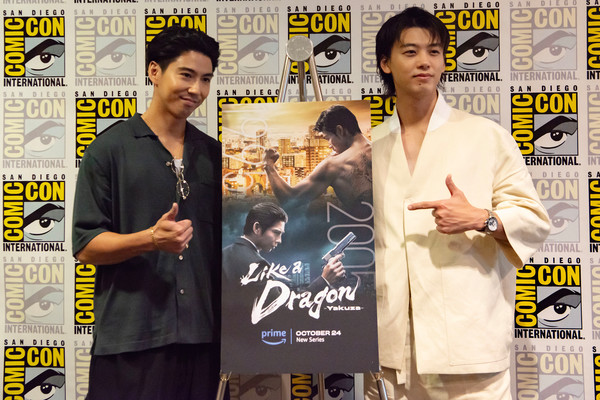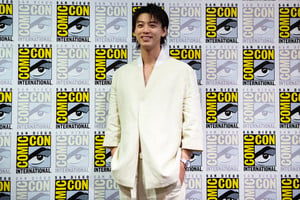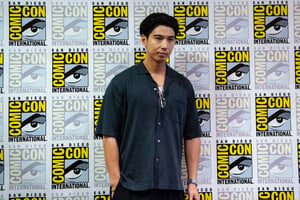How the Like a Dragon: Yakuza Actors Embody the Source Material
by Kalai Chik,
Amazon Prime's TV adaptation of SEGA's global hit Yakuza series will be available to stream in just a few months. Their recently released official trailer featured a look into the cast behind Kazuma Kiryu and his childhood friend, Akira Nishikiyama. Played by Ryōma Takeuchi and Kento Kaku, respectively, the live-action teases glimpses of their lives from 1995 to 2005. While those in the panel were able to see exclusive clips from the upcoming series, the public will have to wait longer before they'll be able to view it.
Immediately after their rousing San Diego Comic-Con panel, the two lead stars sat down with Anime News Network at a roundtable interview to thoroughly walk through the underground world of gangsters.

During the panel, you both mentioned how you talked about the series together. What exactly about Like a Dragon: Yakuza do you both discuss?
Ryōma Takeuchi: We were together all the time, so we had small things, details, and big conversations about things that were not in the script. I think we delved into the characters to try and figure out who they are. In a sense, that was a kind of the inception of all these things.
The fight sequences were extraordinary, especially the first one. We see the evolution of the character from 1995 to 2005. Can you talk about the training that went into this? How did you overcome the challenge of portraying him as inexperienced in the fighting realm instead of becoming an experienced yakuza member?
Takeuchi: We had a lot of conversations with the trainer, who evidently tried to differentiate the fighting styles between 1995 and 2005. In 1995, the fights were more about emotions. The sort of libido of the youngster trying to fight, but he doesn't have that "kata" yet. Getting into 2005, it's completely different because he's grown into a yakuza, almost like a kingpin. He's getting that formula of fighting, and that's completely different. We tried to make that differentiation. The director, Take-san, really likes headbutts.

Masaharu Take is known for dramas but also comedy-dramas like The Naked Director, which has a similar tone to Like a Dragon: Yakuza. How did director Take guide you both in your roles?
Kento Kaku: He's very supportive of us, especially when I worry about my character. He always gives me a hint. Also, he's very knowledgeable about yakuza culture because he has a lot of experience doing yakuza movies. He met professional yakuza members in person and lived to tell the tale.
Takeuchi: He's just so passionate. The most impressive part of Take-san's direction is that he's the most passionate person on set. His energy drags everybody into doing better performances. He has this tactic to work with actors. At the same time, he actually casts background actors himself. There are about 400 yakuza performers in this show, but he cast every single one of them to make sure that they have the sort of sensibility entwined into all the looks of the yakuza.
About the dynamic of your characters, specifically as inspired by the big crime that happens at the beginning of episode one, how does that inform your characters in 1995? How does it inspire their fractured relationship in 2005?
Kaku: The relationship is a key element in this show, and it's a very complicated relationship. At the beginning of the show, they are like brothers, but at one point, their relationship becomes worse and worse. Eventually, Nishiki falls to the dark side.
Takeuchi: The first cold open is extremely important for the show. I think it just represents the bond the two characters have because they are in cahoots with this conspiracy to steal money. But at the same time, they're kind of rivals. They sort of stimulate each other, in a sense. When Kiryu decides and begs to join the yakuza clan, there's this kind of rivalry happening. At the same time, Kiryu is overeliant. He's relying on the bond that he has with Nishiki. It feels like they're very sharp and bonded, but there's already a fraction there that represents the whole story.
In 1995, we see Kiryu and Nishiki as their young, naive selves. They make mistakes, get very angry, and passionate. What are these characters to Ryōma Takeuchi and Kento Kaku?
Takeuchi: Director Take always talked about how the differences between 1995 and 2005 need to be shown through the lighting and colors. The characters are represented in warmer and hotter colors in 1995 versus the more cold and blue tones of 2005. The contrast is really important, and Take-san has always told us that we shouldn't want to look cool or stylish in the 1995 scenes because that's going to happen in 2005.
Was there anything in the script with these characters that you related to that helped you get into the character and the mindset of the characters as brothers?
Kaku: Nishiki is very human. He has just about every emotion that one human being can have. When I read the script for the first time, I really fell in love with his character. In 1995, he was very emotional and instinctive. But in 2005, he is very cold but has silent rage within him. I love him.
Takeuchi: Compassion. I think Kiryu is very hard on the outside but very soft on the inside. That thoughtfulness and emotional element that craves human connection is the part that resonates most with me. Not having a family in your youth just scars you forever. Even if you grow up and be a big guy, it doesn't matter. You're looking for human connection and relationships. Kiryu's drive is coming from that. That's why he dug into and went into Kamurocho to get his human relationships.
Coming from an American's perspective, whose image of the yakuza is evil, to see Kiryu centered as a hero in that environment is very intriguing. It's not common to see that on TV.
Takeuchi: Kiryu is someone who wants to stand up for people or stand up for somebody else. Trying to be a hero is one of his goals in life. I wouldn't have been part of the project if that essence wasn't in this property. I think it just embodies this drama. Everybody's lonely! The kingpins are kind and compassionate in their ways, which draws people in because they're lonely and looking for a father figure.
During the panel, you mentioned you purposely wanted to avoid simply cosplaying as the character. How did you avoid that in your role?
Kaku: When I talked with Director Take, he wanted to follow the character in the script and explore him by developing him from scratch. We wanted to make a new vision of this character by diving deep into his core relationships. The main focus was to look into the drive that they have from within that pushes them to their ultimate objectives. That's what brought out the essence of creating a new, original version of the character. We were able to dig deeper into the emotional aspects more so than the game.
Takeuchi: There are a few steps to adapting one property from one medium to another. It starts with respect and knowing the property in and out. Then, let it go at some point when you start shooting because you have to embody the character in your own way. That's the thing that really interested me in this project. I wouldn't have done a project like this if it weren't for a director like Take-san, who wanted to start from scratch even though we knew the property as well as anybody around us. We start from scratch, we're paying respect to the series, but we're also able to let go and be ourselves. Ultimately, we get closer to the source material. You let it go, but once you embody the character and the spiritual element of the character, you start to resemble the source material. You learn to trust yourself, and that might be the most surprising element of this show.